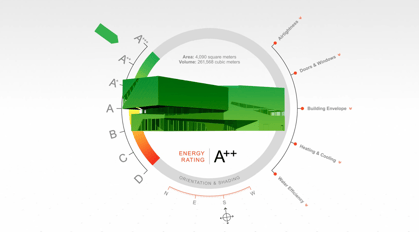When you think about the sustainability of buildings, you may tend to think first of the big topics of energy, water, materials, and air. These factors are of course linked to the creation of environmentally friendly buildings.
But there’s more to be discussed when it comes to sustainable architecture. Site conditions, location, density, transit, and more can all have a huge impact on a project.
Many of these principles are measured by all the major green building rating systems around the world, which include LEED, BREEAM, and Greenstar, which dominate the US, UK, and Australian markets respectively. While they might vary in terms of scope, measurement, and proof of performance, their similarities are guided by core principles. In this article, we’ll concentrate on LEED (Leadership in Energy and Environmental Design).
For a project to achieve its highest LEED score, it needs to have been strategized to advance environmental welfare. There are several factors in this area measured by LEED that we’ll discuss in this blog post.
 ENERGY MODELING IN THE EARLY DESIGN PHASE
ENERGY MODELING IN THE EARLY DESIGN PHASE
Looking for ways to make your projects more sustainable? This free webinar explores methods in Vectorworks to start achieving your goals early in a project.
SITE CONDITIONS & PROJECT LOCATION
NEIGHBORHOOD DEVELOPMENT LOCATION
In this category there are three major items considered by LEED:
- Avoiding development on inappropriate sites
- Reducing vehicle distance traveled
- Enhancing livability and improving human health by encouraging daily physical activity
Achieving these goals means you’re developing on a site that is near local amenities such as restaurants or shopping centers. Being located near public parks or trails encourages the “daily physical activity” mentioned by LEED.
BROWNFIELD SITES & ADAPTIVE REUSE
Avoiding sensitive land — such as prime farmland, floodplains, special habitats, water bodies, and wetlands — is a critical factor to recognize when deciding on the location of a building. Often, this can be done by taking advantage of previously developed land.
Redeveloping a brownfield is a highly sustainable practice that falls into this category. Adaptive reuse, or recycling buildings or sites for different purposes than the original, is similarly advantageous.
DIVERSE USES, EQUITABLE DEVELOPMENT, & DENSITY
HIGH-PRIORITY SITE AND EQUITABLE DEVELOPMENT
The main goals of this category are to encourage uplifting the “economic and social vitality of communities,” and to “encourage project location in areas with development constraints and promote the ecological and community health of the surrounding area."
So, as an example, locating a new community center in a disadvantaged area can increase the project’s LEED score. LEED outlines what “disadvantaged area” means here.
SURROUNDING DENSITY AND DIVERSE USES
Building near existing infrastructure is preferred to building away from it. LEED outlines precise distances and density metrics to reference.
A project can score points for having proximity to other buildings with separate public uses. If you’re building a retail store, you can score points for being located within half a mile (800 meters) of restaurants, other retail shops, public schools, etc.
TRANSIT & REDUCED VEHICLE FOOTPRINT
ACCESS TO QUALITY TRANSIT
Access to reliable public transit reduces the need for people to drive their own cars, and cars are a big contributor to worldwide greenhouse gas emissions.
BICYCLE FACILITIES
Continuing with the theme, accommodating bicycles is another way to up the sustainability level of a building. Encouraging commuters to bicycle to the building instead of drive reduces carbon emissions from transportation associated with the project.
“Facilities” refers to accommodations such racks for storage and shower rooms. In addition to reducing transportation emissions, including these items in a project contributes to a reduced parking footprint.
REDUCED PARKING FOOTPRINT
Dense areas are likely to have heavier parking needs. Parking facilities are environmentally harmful due to “automobile dependence, land consumption, and rainwater runoff.”
There are a variety of ways to reduce a project’s associated parking footprint, including:
- Not providing off-street parking
- Providing dedicated parking for carshare vehicles
- Selling parking separately from property sales or leases
ELECTRIC VEHICLES
Electric vehicles are more environmentally friendly because they emit less greenhouse gas. You can encourage electric vehicle use by making sure to include at least one charging station in the design of your project. This can have a positive effect on the project’s LEED score.
🌏 GREEN RATING SYSTEMS AROUND THE WORLD 🌍
This article focuses on the LEED rating system. For more information on other green rating systems used around the world, Whole Building Design Guide has a helpful webpage that breaks it all down.

.svg)





